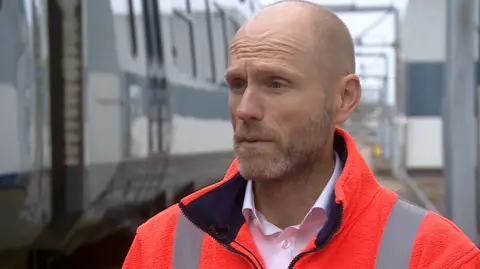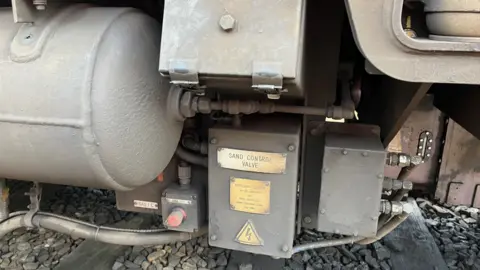Trains fitted with 'leaf-busting' brake system
 BBC
BBCA new system to improve train braking during slippery autumn leaf fall has been fitted to the type of train involved in two serious crashes.
It pours up to 5kg of sand a minute on to the rails, in front of the wheels, to improve grip.
Tests show it can stop a train on slippery rails in half the distance of older equipment.
It has been fitted to a fleet of 39 trains at Salisbury depot. The trains are used on the west of England line between London Waterloo and Exeter, and on services through Romsey.
Similar Class 158 / 159 diesel trains were involved in a fatal crash at Talerddig in Wales last month, and in a crash at the entrance to Salisbury tunnel in 2021.
In both incidents, trains passed signals set at danger, moving into the path of another service.
Poor adhesion in areas known for heavy leaf fall was a major factor in each crash.
When leaves are crushed into a thin black coating, the head of the rail becomes as slippery as ice.
The contact patch between a train wheel and the rail is the size of a five pence coin. Even with brakes fully on, a train can slide across the rail, unable to grip.
New equipment, developed by Siemens and funded by Network Rail, has been fitted to the 30-year-old South Western Railway trains.
"It increases the friction level between the wheel and rail," explained Neil Drury, engineering director at SWR. "The greater the friction, the better the braking.
"These trains weren't originally fitted with sanders at all. The first generation was a single shot: the driver used it in an emergency.
"Next was a standard-rate sander. Now we have a variable-rate system, releasing sand in relation to train speed and track conditions."
Tests by the Rail Safety and Standards Board show it can stop a train on slippery wet rails in half the distance of previous equipment, one quarter of the distance of a train with no sanding at all, and double the distance of a similar train braking in ideal conditions on dry rails.
Could the new equipment have prevented the crashes at Salisbury tunnel and Talerddig?
"It's a good question, but we can't tell," said Mr Drury. "The top of the rail surface at Salisbury was particularly contaminated. What we can say is that the sand system is an incremental step more effective than was fitted previously."

The new equipment is in addition to existing specialist railhead treatment trains used daily by Network Rail to clear leaf mulch between October and December each year. They spray a gel on to the track.
All these methods treat the effect, not the cause, of slippery rails. Cutting down more lineside vegetation would prevent the problem in the first place.
Network Rail spokesman Rob Breckon said: "We do a lot of things to tackle leaf fall, particularly on this route. It includes chopping down trees, as part of our programme of vegetation management.
"But we have to do that in a responsible way, and it is not possible to cut down every tree that lines the railway."
You can follow BBC Hampshire & Isle of Wight on Facebook, X (Twitter), or Instagram.
